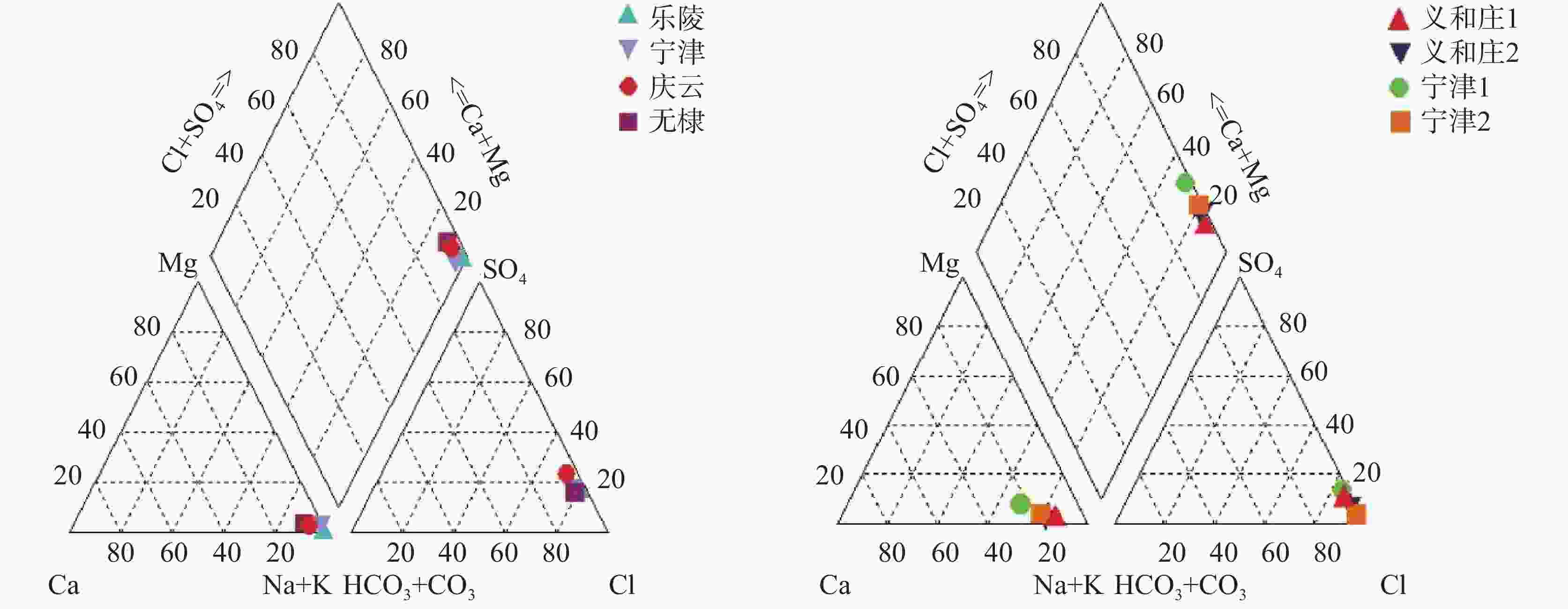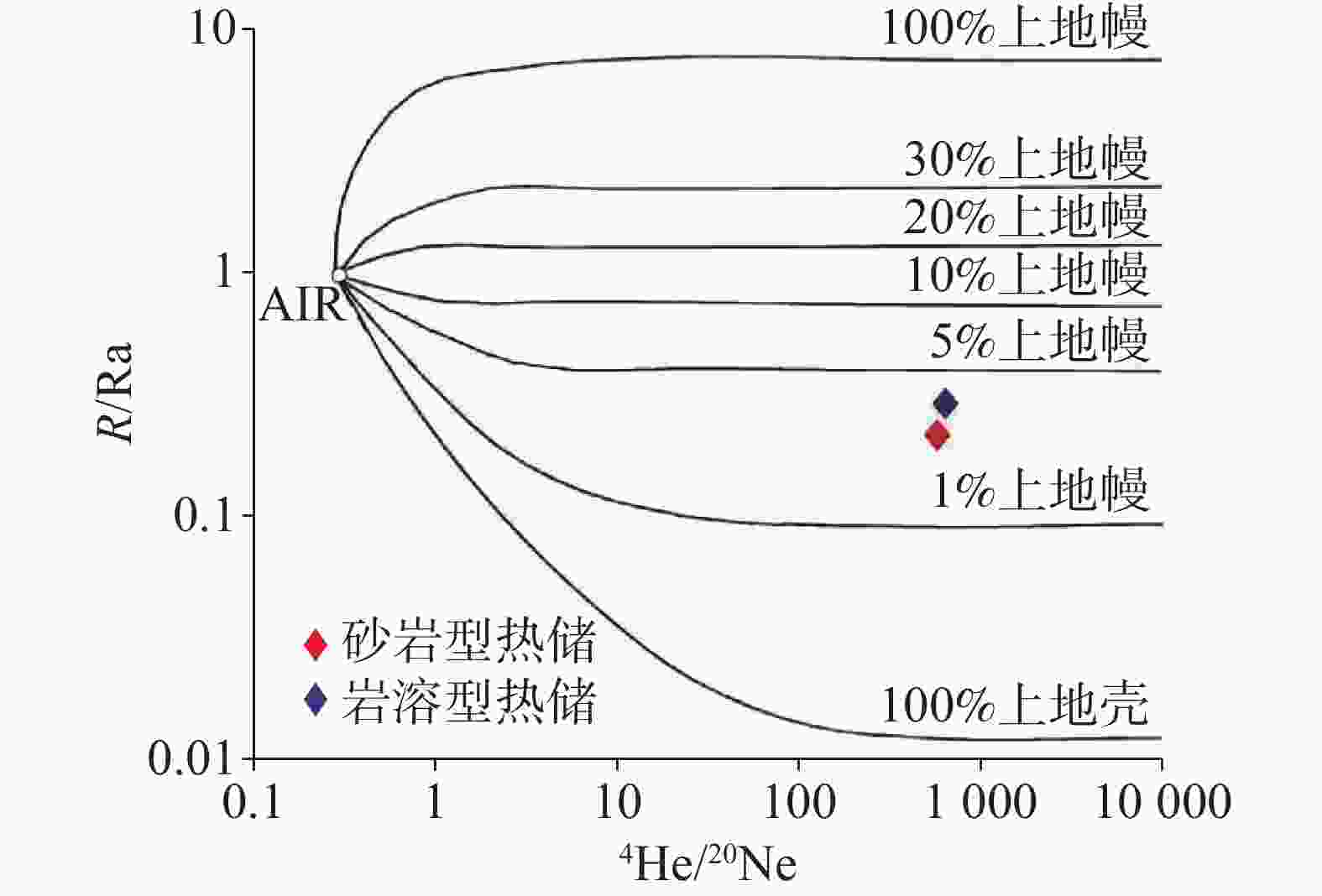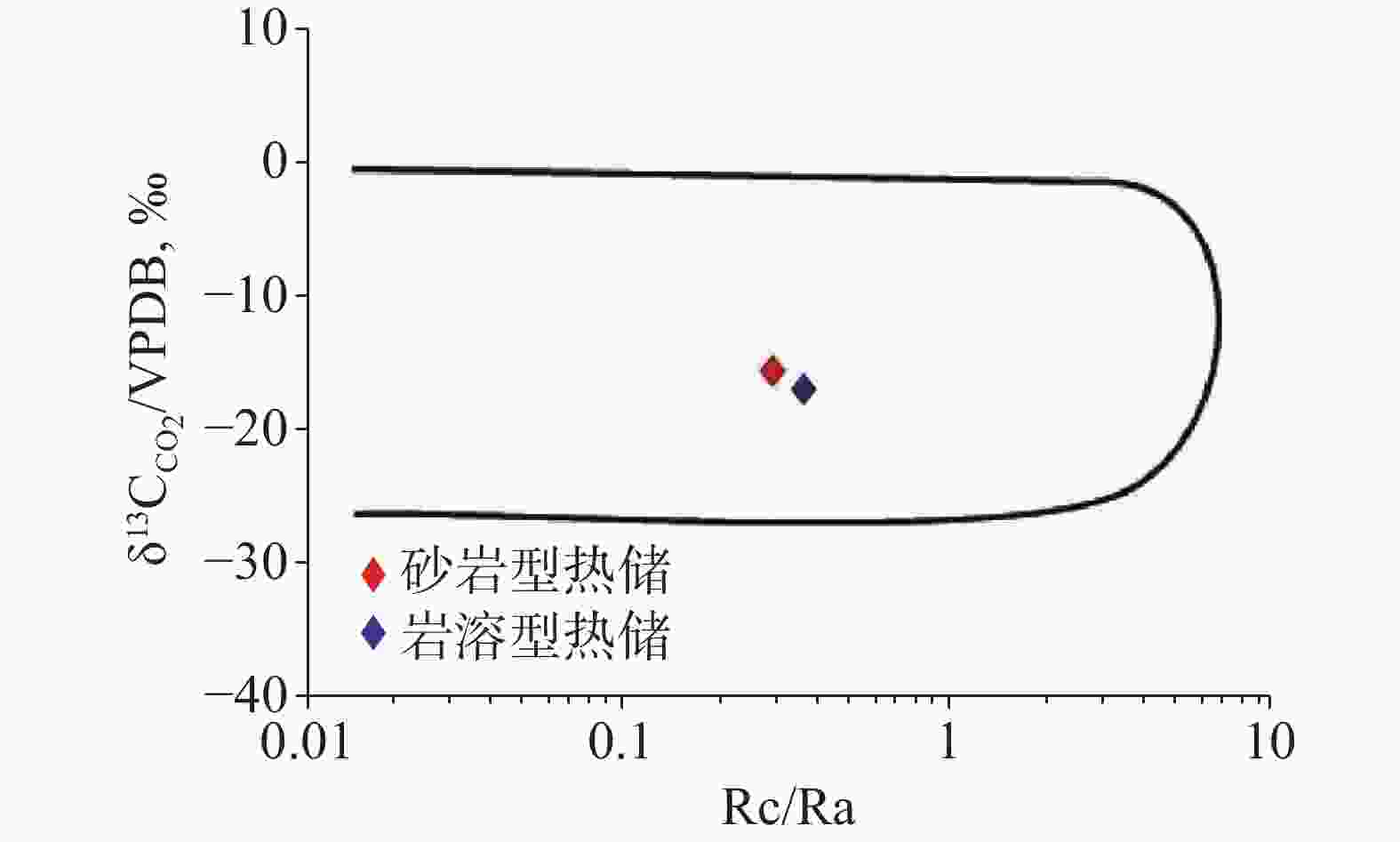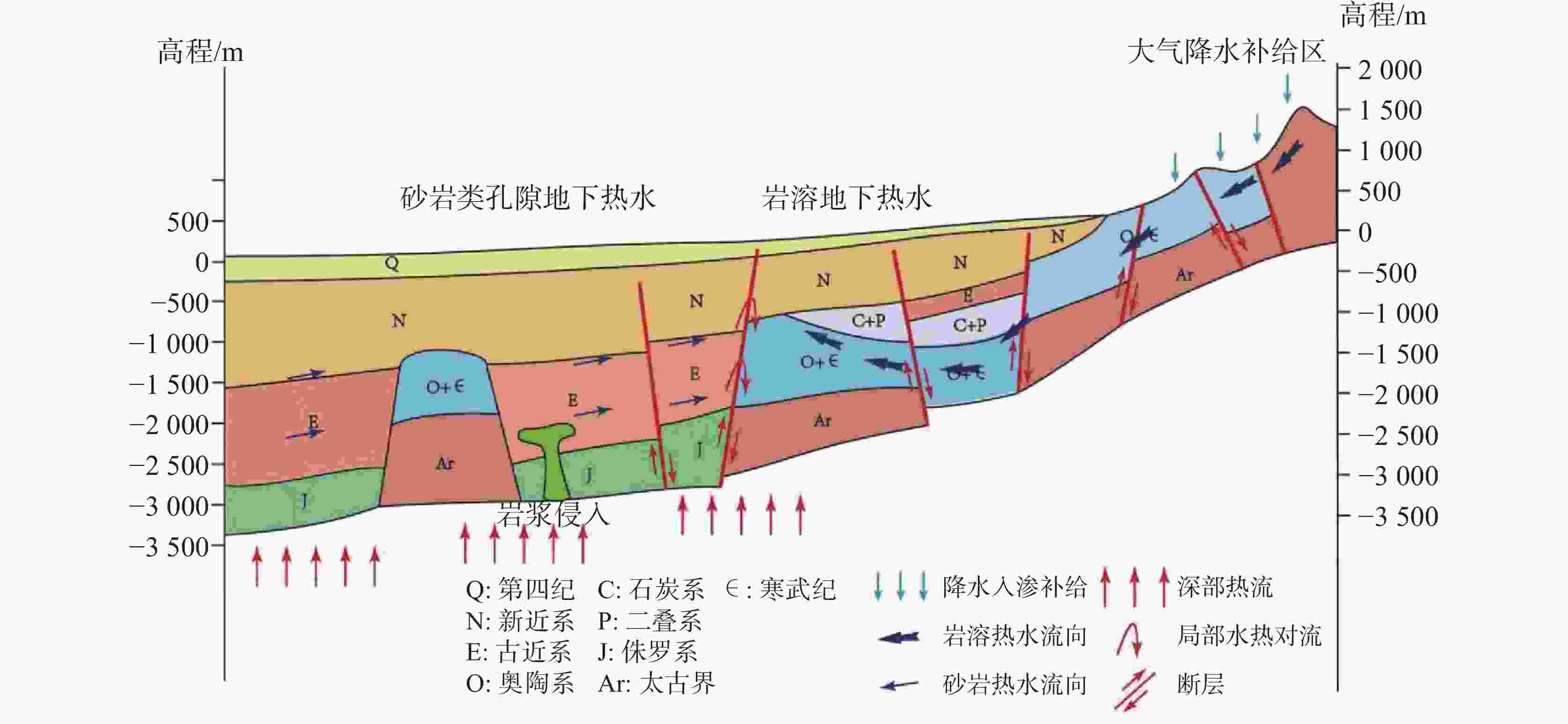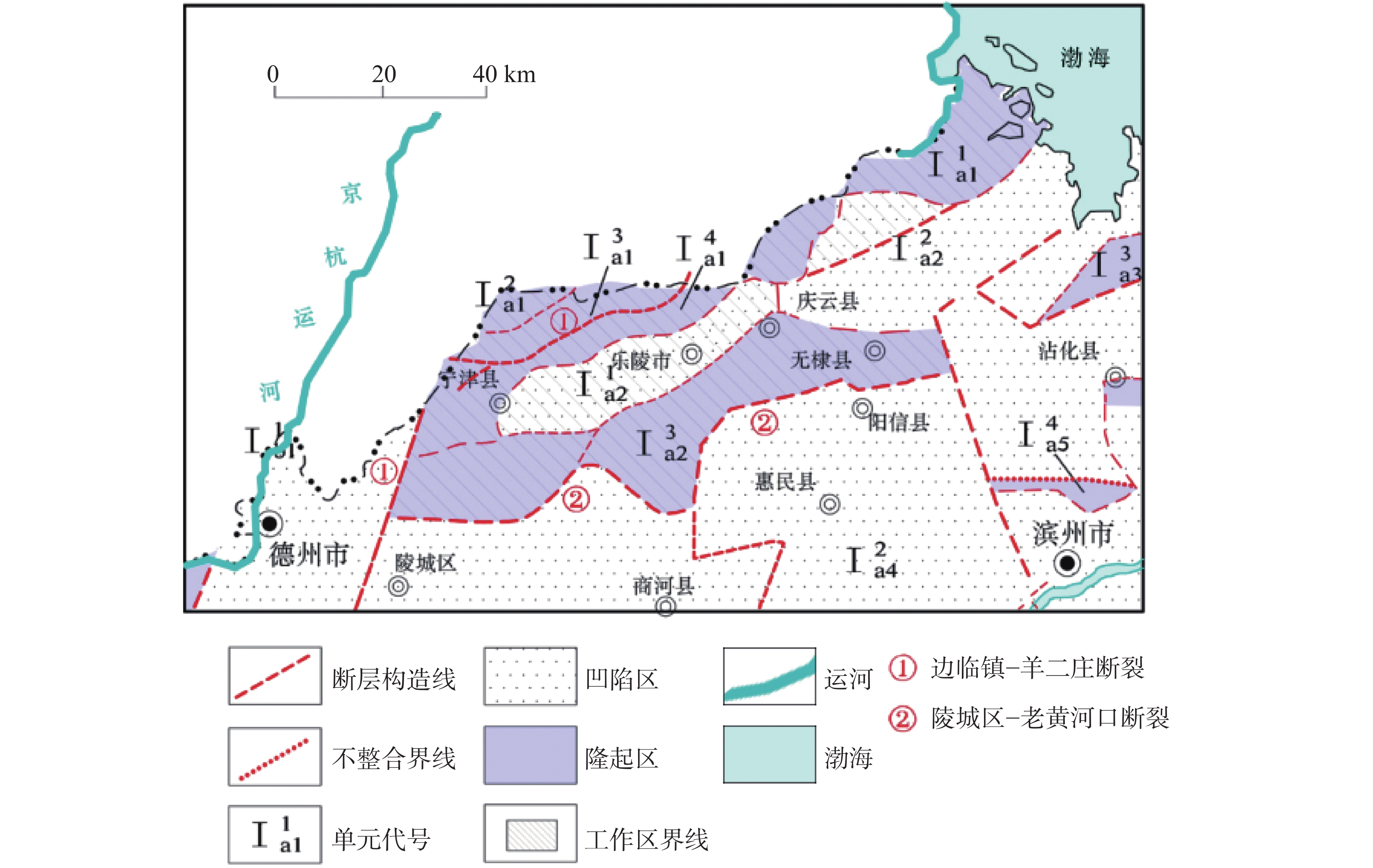Comparative analysis of the genesis models of different geothermal reservoirs in Chengning uplift area in northwest Shandong based on hydrochemical isotope technology
-
摘要: 埕宁隆起区是我国重要的地热资源富集地区之一,了解地热田的成因模式对于地热资源的可持续开发利用具有重要意义。采用水化学同位素手段,对埕宁隆起区馆陶组砂岩热储和寒武−奥陶系岩溶热储成因进行对比分析,结果表明:砂岩热储地热水是地质历史时期的大气降水入渗补给的产物,为侧向径流补给水,而岩溶热储地热水不是直接来源于大气降水的就近入渗补给,而是经过较长距离的径流过程,具有明显的氢氧漂移现象。两套热储地热水补给高程、热储温度及热水循环深度分别为459 m和557 m、66 ℃和72 ℃、1 420 m和1 795 m。此外,研究成果还揭示埕宁隆起区地热水补给区位于泰山地区,其地热系统热源为地壳深部及少部分上地幔传导热流。Abstract:
The Chengning Uplift Area is one of the important areas rich in extremely abundant geothermal resource in China. At present, geothermal resources in the study area are mostly used in the fields such as bathing, medical treatment, and heating. According to the existing geothermal geological data and analysis results, the total geothermal resources in this area are 1.70×1020 J, equivalent to 57.86×108 t of standard coal. Therefore, elucidating the genesis model of geothermal fields in this area is of great significance for the sustainable development and utilization of geothermal resources. This study uses hydrochemical isotope technology to compare and analyze the genesis of the sandstone thermal reservoir of Guantao Formation and the Cambrian-Ordovician karst thermal reservoir in the Chengning Uplift Area. The research results indicate that the cations in the geothermal water from sandstone and karst thermal reservoirs in this area are mainly Na+, and the anions are mainly Cl-. The mineralization degree of geothermal water in sandstone thermal reservoir is 4.19–5.96 g·L−1, with a pH value of 7.35–9.43, indicating neutral to weakly alkaline water. The mineralization degree of geothermal water in karst thermal reservoir is 5.91–11.10 g·L−1, and the pH value is 6.50–7.29; therefore, it is classified as neutral water according to its acidity and alkalinity. The geothermal water from sandstone thermal reservoir in this area is a product of atmospheric precipitation infiltration and replenishment during geological history, supplying water by lateral runoff. However, the geothermal water in karst thermal reservoir does not directly come from the nearest infiltration recharge of atmospheric precipitation, but through a longer distance runoff process, which has an obvious phenomenon of hydrogen and oxygen drift. The two sets of elevation of geothermal water supply, temperature of thermal reservior and depth of hot water circulation are respectively 459 m and 557 m, 66 ℃ and 72 ℃, and 1,420 m and 1,795 m. From this, it can be seen that geothermal water in the study area is in a well-sealed geological environment, without shallow water mixing, and is deep circulating geothermal water. In addition, the research results also reveal that the supply area of geothermal water of Chengning Uplift is located in the Mount Tai area, and the heat source of its geothermal system is the heat flow conducted from the deep crust and a small part from the upper mantle. The deep fault in the study area generated a certain amount of frictional heat during its active period, and also served as a good channel for underground heat flow, connecting and conducting upwards the heat generated by magma in the deep crust and upper mantle. In addition, the area is a sedimentary basin with deep depression, which generates gravity compression heat under the pressure of the thick Meso-Cenozoic sedimentary layer. The heat generated by these sources is stored in the pores and cracks of the thermal reservoir under the thermal insulation effect of the cover layer with strong thermal resistance and poor thermal conductivity, and is the main heat source for the formation of hot water in the area. -
图 3 砂岩型和岩溶型地热水Na−K−Mg 平衡图解[21]
Figure 3. Na-K-Mg equilibrium diagram of sandstone and karst geothermal water
表 1 地热水水化学成分表
Table 1. Hydeochemical composition list of geothermal water
热储类型 砂岩热储 岩溶热储 K+/mg·L−1 10.80~19.95 31.10~41.50 Na+/mg·L−1 1 540.00~2 036.25 1 541.00~1 896.25 Ca2+/mg·L−1 6.01~131.90 230.46~720.00 Mg2+/mg·L−1 12.15~39.80 35.84~144.00 Cl−/mg·L−1 1 896.58~2 746.69 3 008.82~3 163.91 ${\rm{SO}}_4^{2-}$/mg·L−1 566.75~999.02 315.80~1 198.00 ${\rm{HCO}}_3^{-}$/mg·L−1 79.33~299.00 146.45~275.00 矿化度/g·L−1 4.19~5.96 5.91~11.10 pH 7.35~9.43 6.50~7.29 水化学类型 Cl-Na Cl-Na 表 2 基于SPSS离子相关性分析
Table 2. Correlation analysis of ions based on SPSS
热储类型 离子相关性 K+ Na+ Ca2+ Mg2+ Cl− ${\rm{SO}}_4^{2-}$ ${\rm{HCO}}_3^{-}$ 矿化度 pH 馆陶组砂
岩热储K+ 1.000 0.666 −0.232 0.571 0.501 −0.155 0.696 0.495 0.311 Na+ 1.000 0.455 0.932 0.872 0.549 0.969 0.970 −0.376 Ca2+ 1.000 0.660 0.725 0.506 0.436 0.657 −0.966 Mg2+ 1.000 0.980 0.393 0.936 0.966 −0.593 Cl− 1.000 0.333 0.878 0.932 −0.667 ${\rm{SO}}_4^{2-}$ 1.000 0.508 0.611 −0.481 ${\rm{HCO}}_3^{-}$ 1.000 0.964 −0.356 矿化度 1.000 −0.590 pH 1.000 寒武系−奥陶系
岩溶热储K+ 1.000 0.738 −0.731 −0.737 −0.476 −0521 −0.887 −0.560 0.663 Na+ 1.000 −0.677 −0.891 −0.187 −0.958 −0.868 −0.306 0.947 Ca2+ 1.000 0.929 0.849 0.608 0.932 0.907 −0.829 Mg2+ 1.000 0.596 0.857 0.964 0.688 −0.976 Cl− 1.000 0.112 0.629 0.992 −0.419 ${\rm{SO}}_4^{2-}$ 1.000 0.759 0.225 −0.948 ${\rm{HCO}}_3^{-}$ 1.000 0.720 −0.910 矿化度 1.000 −0.521 pH 1.000 表 3 基于SPSS地热水主成分分析
Table 3. Principal component analysis of geothermal water based on SPSS
离子类型 砂岩热储地热水 岩溶热储地热水 1 2 3 1 2 3 K+ 0.461 0.881 −0.107 −0.815 0.000 0.579 Na+ 0.945 0.281 0.165 −0.863 0.501 0.059 Ca2+ 0.716 −0.664 −0.216 0.955 0.285 0.082 Mg2+ 0.980 0.116 −0.164 0.989 −0.088 0.119 Cl− 0.961 0.033 −0.276 0.657 0.747 0.103 ${\rm{SO}}_4^{2-}$ 0.569 −0.385 0.726 0.790 −0.574 0.213 ${\rm{HCO}}_3^{-}$ 0.940 0.314 0.130 0.991 −0.010 −0.137 矿化度 0.995 0.053 0.090 0.745 0.663 0.080 pH −0.652 0.722 0.231 −0.940 0.291 −0.178 表 4 基于PHREEQC反向水文地球化学模拟
Table 4. Reverse hydrogeochemical simulation based on PHREEQC
矿物组分 地下水渗流路径 砂岩热储 岩溶热储 方解石CaCO3 3.878×10−4 −2.966×10−2 白云石CaMg(CO3)2 1.129×10−3 6.739×10−2 岩盐NaCl 2.389×10−3 −1.243 石膏CaSO4·2H2O 2.297×10−3 4.543×10−1 钾长石KAlSi3O8 8.452×10−3 伊利石K0.65{Al2[Al0.65Si3.35O10](OH)2} 3.796×10−2 表 5 砂岩和岩溶热储地热水氢氧同位素数据表
Table 5. Hydrogen and oxygen isotope data of geothermal water in sandstone and karst reservoirs
热储层位 取样点 地面高程/m δD-2H/‰ δ18O/‰ 新近系馆陶组
砂岩热储无棣 5.0 −73.0 −9.2 乐陵 22.0 −70.0 −8.5 乐陵 22.3 −67.0 −9.2 宁津 17.0 −73.0 −8.7 庆云 10.0 −71.0 −8.5 寒武-奥陶系
岩溶热储德州 19.0 −77.3 −10.6 宁津 20.0 −75.0 −9.5 宁津 17.0 −75.0 −9.7 乐陵 19.0 −80.3 −9.9 宁津 22.0 −80.6 −9.6 表 6 地热水水温及热储温度
Table 6. Geothermal water temperature and thermal reservoir temperature
热储层 井口水温/ ℃ 热储温度/℃ 新近系馆陶组砂岩热储 50~58 66 寒武系-奥陶系岩溶热储 65~70 72 表 7 地热储层地温梯度及地热水循环深度
Table 7. Geothermal gradient and depth of geothermal water circulation of geothermal reservoir
热储层 地温梯度/℃·hm−1 循环深度/m 新近系馆陶组砂岩热储 3.70 1 420 寒武系−奥陶系岩溶热储 3.23 1 795 表 8 地热气体中N2-Ar-He比值
Table 8. N2-Ar-He ratio in geothermal gas
热储层 N2/Ar N2/He 新近系馆陶组砂岩热储 70.49 61.12 寒武系−奥陶系岩溶热储 57.67 72.33 表 9 地热气体中He同位素组成及特征
Table 9. Composition and characteristics of He isotopes in geothermal gas
热储层 R/Ra 3He/4He(10−7) 4He/20Ne He(10−6) 新近系馆陶组
砂岩热储0.27 3.73 837 15 957 寒武系−奥陶系
岩溶热储0.37 5.17 886 12 997 表 10 地热气体中CO2同位素组成及特征
Table 10. Composition and characteristics of CO2 isotopes in geothermal gas
热储层 R/Ra 3He/4He(10−7) 4He/20Ne He(10−6) δ13${\rm{C}}_{\rm{CO_2}} $(‰) 新近系馆陶组砂岩热储 0.27 3.730 837 15 957 −15.3 寒武系−奥陶系岩溶热储 0.37 5.167 886 12 997 −17.8 -
[1] Diego Moya, Clay Aldás, Prasad Kaparaju. Geothermal energy: Power plant technology and direct heat applications[J]. Renewable and Sustainable Energy Reviews, 2018, 94: 889-901. [2] E Pastor Martinez, C Rubio Maya, V M Ambriz Díaz, J M Belman Flores, J J Pacheco Ibarra. Energetic and exergetic performance comparison of different polygeneration arrangements utilizing geothermal energy in cascade[J]. Energy Conversion and Management, 2018, 168(1): 252-269. [3] 王浩, 赵季初. 鲁西北平原区地热资源开发对地下水环境的影响[J]. 山东国土资源, 2015, 31(7):36-39.WANG Hao, ZHAO Jichu. Effect of geothermal resources exploitation to groundwater environment in northwestern plain in Shandong Province[J]. Shandong Land and Resources, 2015, 31(7):36-39. [4] 王彦俊, 刘桂仪, 胡松涛. 鲁北地区地热资源区划研究[J]. 地质调查与研究, 2008, 31(3):270-277. doi: 10.3969/j.issn.1672-4135.2008.03.020WANG Yanjun, LIU Guiyi, HU Songtao. Division of the geothermal resources in the northern Shandong Province[J]. Geological Survey and Research, 2008, 31(3):270-277. doi: 10.3969/j.issn.1672-4135.2008.03.020 [5] 赵季初, 纪洪磊, 刘欢. 鲁北平原地下咸水浅层地热能开发利用条件研究[J]. 中国地质调查, 2020, 7(3): 13-20.ZHAO Jichu, JI Honglei, LIU Huan. Study on the development and utilization prospection of shallow geothermal energy of saline underground water in northern Shandong Plain[J]. Geological Survey of China, 2020, 7(3): 13-20. [6] 张保建. 鲁西北地区地下热水的水文地球化学特征及形成条件研究[D]. 北京: 中国地质大学(北京), 2011.ZHANG Baojian. Hydrogeochemical characteristics and formation conditions of the geothermal water in northwestern Shandong Province[D]. Beijing: China University of Geosciences (Beijing), 2011. [7] 刘志涛, 刘帅, 宋伟华, 杨询昌, 周群道. 鲁北地区砂岩热储地热尾水回灌地温场变化特征分析[J]. 地质学报, 2019, 93(Suppl.1):149-157.LIU Zhitao, LIU Shuai, SONG Weihua, YANG Xunchang, ZHOU Qundao. Change characteristics of geothermal field for geothermal return water reinjection of sandstone reservoir in the northern Shangdong[J]. Acta Geologica Sinica, 2019, 93(Suppl.1):149-157. [8] 王卫星, 孙玉东, 杨永江, 王光辉, 赵娜. 天津市东丽湖地热对井的地质与水文地球化学特征[J]. 物探与化探, 2010, 34(1):44-48.WANG Weixing, SUN Yudong, YANG Yongjiang, WANG Guanghui, ZHAO Na. Geological and hydrogeochemical characteristics geothermal paired wells in Dongli lake area Tianjin[J]. Geophysical and Geochemical Exploration, 2010, 34(1):44-48. [9] Craig H. Standard for reporting concetrations of deuterium and oxygen-18 in natural water[J]. Science, 1961, 133:1833-1834. [10] Maloszewski Piotr, Rauert Werner, Trimborn Peter, Herrmann Andreas, Rau Rolf. Isotope hydrological study of mean transit times in an alpine basin (Wimbachtal, Germany)[J]. Journal of Hydrology, 1992, 140(1):343-360. [11] Davisson M L, Smith D K, Kenneally J, Rose T P. Isotope hydrology of Southem Nevada groundwater: Stable isotopes and radiocarbon[J]. Water Resource Research, 1999, 35(1):279-294. doi: 10.1029/1998WR900040 [12] 冯明扬, 宋汉周, 杨谦, 刘加才. 江苏部分地热水的气体成分和微量元素含量特征及其指示意义[J]. 水文地质工程地质, 2016, 43(1):164-170.FENG Mingyang, SONG Hanzhou, YANG Qian, LIU Jiacai. Characteristics of dissovled gases and trace element in geothermal waters in Jiangsu and their tracing significance[J]. Hydrogeology & Engineering Geology, 2016, 43(1):164-170. [13] 罗璐, 庞忠和, 罗霁, 李义曼, 孔彦龙, 庞菊梅, 王迎春. 惰性气体同位素确定地热流体循环深度[J]. 地质科学, 2014, 49(3):888-898.LUO Lu, PANG Zhonghe, LUO Ji, LI Yiman, KONG Yanlong, PANG Jumei, WANG Yingchun. Noble gas isotopes to determine the depth of the geothermal fluid circulation[J]. Chinese Journal of Geology, 2014, 49(3):888-898. [14] 杨询昌, 康凤新, 王学鹏, 付庆杰, 刘志涛. 砂岩孔隙热储地温场水化学场特征及地热水富集机理:鲁北馆陶组热储典型案例[J]. 地质学报, 2019, 93(3):738-750. doi: 10.3969/j.issn.0001-5717.2019.03.017YANG Xunchang, KANG Fengxin, WANG Xuepeng, FU Qingjie, LIU Zhitao. Hydrochemical features of geothermal reservoir geotemperature field in sandstone porosity and enrichment mechanism of geothermal water: A case study of geothermal reservoir of Guantao Formation in the Lubei[J]. Acta Geologica Sinica, 2019, 93(3):738-750. doi: 10.3969/j.issn.0001-5717.2019.03.017 [15] 刁海忠, 于桑, 李洪亮, 尹秀贞, 周建伟, 刘红, 王元新. 淄博洪山–寨里煤矿地下水串层污染治理区水化学和硫同位素特征[J]. 中国岩溶, 2023, 42(1):171-181.DIAO Haizhong, YU Sang, LI Hongliang, YIN Xiuzhen, ZHOU Jianwei, LIU Hong, WANG Yuanxin. Analysis on the hydrochemical and sulfur isotope characteristics of the groundwater in cross-strata pollution control area of Hongshan and Zhaili coal mines in Zibo[J]. Carsologica Sinica, 2023, 42(1):171-181. [16] 孙爱群, 牛树银. 地幔热柱演化及其地热效应:华北地热异常的深部构造背景[J]. 地球学报:中国地质科学院院报, 2000, 21(2):182-189.SUN Aiqun, NIU Shuyin. The mantle plume evolution and its geothermal effect: Deep tectonic setting of geothermal anomaly in North China[J]. Journal of Earth Sciences: Journal of Chinese Academy of Geological Sciences, 2000, 21(2):182-189. [17] 吴立进, 赵季初, 李艾银, 邢生霞. 鲁北坳陷区地热资源开发利用关键性问题研究[J]. 地质与勘探, 2016, 52(2):300-306.WU Lijin, ZHAO Jichu, LI Aiyin, XING Shengxia. Key issues of geothermal resource exploitation and utilization in the depression area of northern Shandong Province[J]. Geology and Exploration, 2016, 52(2):300-306. [18] 陈墨香, 黄歌山. 鲁北平原地温分布的特点及地热资源开发利用的前景[J]. 地质科学, 1987(1):1-13.CHEN Moxiang, HUANG Geshan. The characteristics of the geotemperature distribution and the prospects of utilization of geothermal resources in the plain of northern Shandong Province[J]. Chinese Journal of Geology, 1987(1):1-13. [19] 秦耀军, 张平平. 山东省砂岩热储地热资源开发利用模式探讨[J]. 山东国土资源, 2018, 34(10):93-100.QIN Yaojun, ZHANG Pingping. Development and utilization of geothermal resources in the middle and deep layers of Shandong Province[J]. Shandong Land and Resources, 2018, 34(10):93-100. [20] 赵书泉, 周绍智, 邹祖光, 赵季初, 刘桂仪. 山东省鲁北地热田及其可持续开发利用对策[C]//中国能源研究会地热专业委员会. 全国地热产业可持续发展学术研讨会论文集. 化学工业出版社, 2005: 47-52. [21] 栾风娇, 周金龙, 贾瑞亮, 陆成新, 白铭, 梁红涛. 新疆巴里坤–伊吾盆地地下水水化学特征及成因[J]. 环境化学, 2017, 36(2):380-389. doi: 10.7524/j.issn.0254-6108.2017.02.2016062001LUAN Fengjiao, ZHOU Jinlong, JIA Ruiliang, LU Chengxin, BAI Ming, LIANG Hongtao. Hydrochemical characteristics and formation mechanism of groundwater in plain areas of Barkol-Yiwu basin, Xinjiang[J]. Environmental Chemistry, 2017, 36(2):380-389. doi: 10.7524/j.issn.0254-6108.2017.02.2016062001 [22] Giggenbach W F. Geothermal solute equilibria. Derivation of Na-K-Mg-Ca geoindicators[J]. Geochimica Et Cosmochimica Acta, 1988, 52(12):2749-2765. doi: 10.1016/0016-7037(88)90143-3 [23] 许高胜, 马军, 马瑞, 孙自永. 同位素与水化学在地热水形成机理中的应用研究进展[J]. 中国水运(下半月刊), 2010, 10(11):196-198. [24] Craig H. Isotopic variations in meteoric waters[J]. Science, 1961, 133(3465): 1702-1703. [25] 马致远. 环境同位素方法在平凉市岩溶地下水研究中的应用[J]. 地质论评, 2004, 50(4):7. doi: 10.3321/j.issn:0371-5736.2004.04.015MA Zhiyuan. Application of the environmental isotope technique to the study of karst groundwater in Pingliang City[J]. Geological Review, 2004, 50(4):7. doi: 10.3321/j.issn:0371-5736.2004.04.015 [26] 张保建, 徐军祥, 马振民, 沈照理, 亓麟. 运用H、O同位素资料分析地下热水的补给来源:以鲁西北阳谷–齐河凸起为例[J]. 地质通报, 2010, 29(4):603-609. doi: 10.3969/j.issn.1671-2552.2010.04.016ZHANG Baojian, XU Junxiang, MA Zhenmin, SHEN Zhaoli, QI Lin. Analysis on groundwater supply sources using hydrogen and oxygen isotope data: A case study of Yanggu-Qihe salient, northwestern Shandong, China[J]. Geological Bulletin of China, 2010, 29(4):603-609. doi: 10.3969/j.issn.1671-2552.2010.04.016 [27] 吴红梅, 周立岱, 郭宇. 阳离子温标在中低温地热中的应用研究[J]. 黑龙江科技学院学报, 2006(1):27-30.WU Hongmei, ZHOU Lidai, GUO Yu. Application of cation temperature scale in medium-low temperature geothermal resource[J]. Journal of Heilongjiang University of Science and Technology, 2006(1):27-30. [28] 吴亚楠, 杨云涛, 焦玉国, 刘志涛, 王延岭, 翟代廷, 周绍智, 魏凯, 程凤. 山东省岩溶塌陷发育特征及诱因分析[J]. 中国岩溶, 2023, 42(1):128-138, 148. doi: 10.11932/karst2023y007WU Ya'nan, YANG Yuntao, JIAO Yuguo, LIU Zhitao, WANG Yanling, ZHAI Daiting, ZHOU Shaozhi, WEI Kai, CHENG Feng. Analysis on development characteristics and inducement of karst collapse in Shandong Province[J]. Carsologica Sinica, 2023, 42(1):128-138, 148. doi: 10.11932/karst2023y007 [29] Fischer T P, Giggenbach W F, Sano Y, Williams S N. Fluxes and sources of volatiles discharged from Kudryavy, a subduction zone volcano, Kurile Islands[J]. Earth and Planetary Science Letters, 1998, 160(1):81-96. doi: 10.1016/S0012-821X(98)00086-7 [30] 陶明信, 徐永昌, 史宝光, 蒋忠惕, 沈平, 李晓斌, 孙明良. 中国不同类型断裂带的地幔脱气与深部地质构造特征[J]. 中国科学(D辑:地球科学), 2005(5):441-451. [31] 徐永昌, 沈平, 陶明信, 孙明良. 中国含油气盆地天然气中氦同位素分布[J]. 科学通报, 1994, 39(16):1505-1508. [32] Mamyrin B, Tolstikhin I. Helium Isotopes in the earth's atmosphere[J]. Developments in Geochemistry, 1984, 3:203-223. doi: 10.1016/B978-0-444-42180-7.50014-4 [33] 陈浩, 王家鼎, 王琳琳, 杨传伟, 姜福红. 山东省邹城市东部地下水水化学特征及形成机制[J]. 中国岩溶, 2023, 42(1):139-148. doi: 10.11932/karst20230110CHEN Hao, WANG Jiading, WANG Linlin, YANG Chuanwei, JIANG Fuhong. Hydrochemical characteristics and formation mechanism of groundwater in eastern Zoucheng City, Shandong Province[J]. Carsologica Sinica, 2023, 42(1):139-148. doi: 10.11932/karst20230110 [34] Bergfeld D, F Goff, Janik C J. Elevated carbon dioxide flux at the Dixie Valley geothermal field, Nevada, relations between surface phenomena and the geothermal reservoir[J]. Chemical Geology, 2001, 177(1):43-66. -




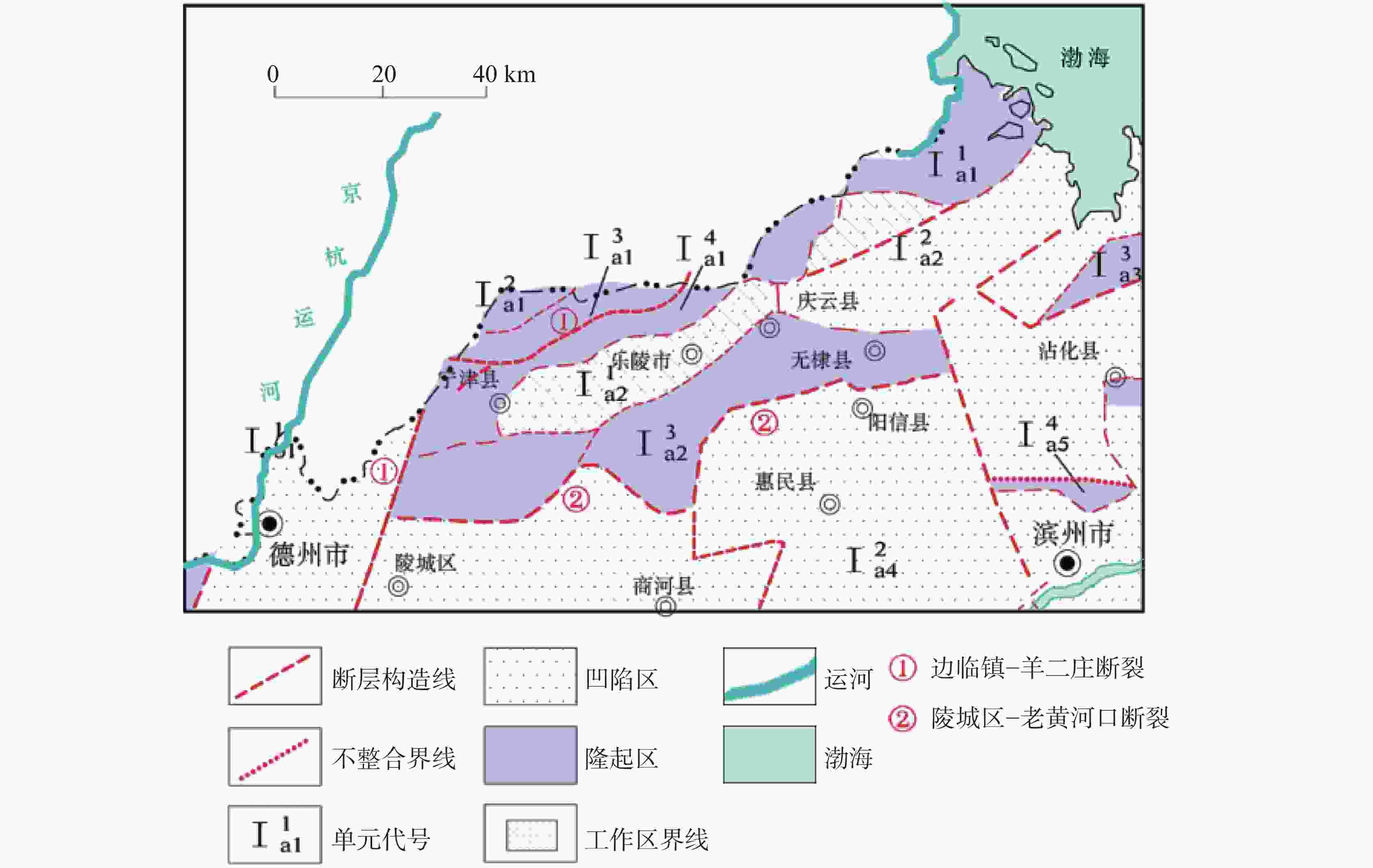
 下载:
下载:
